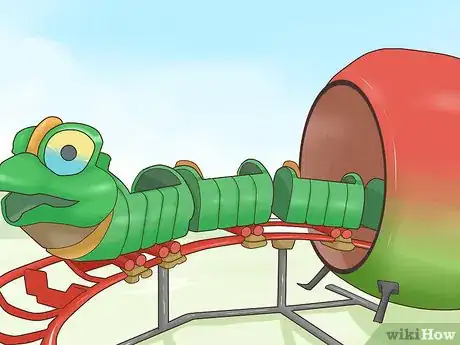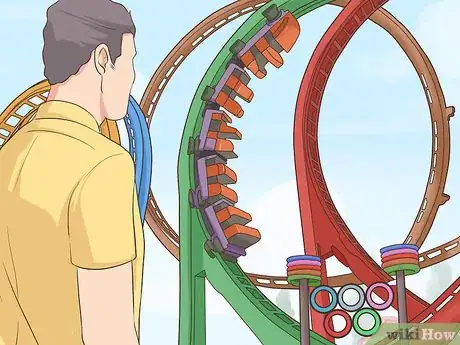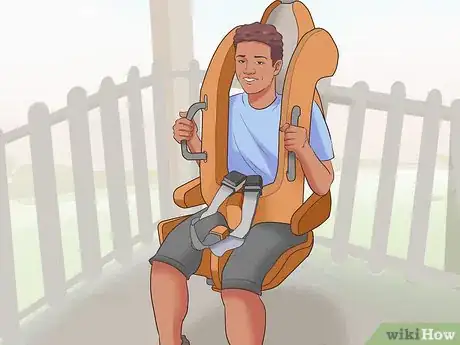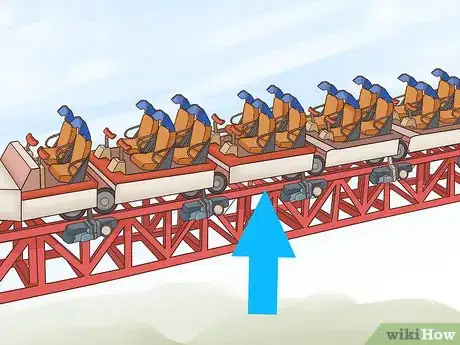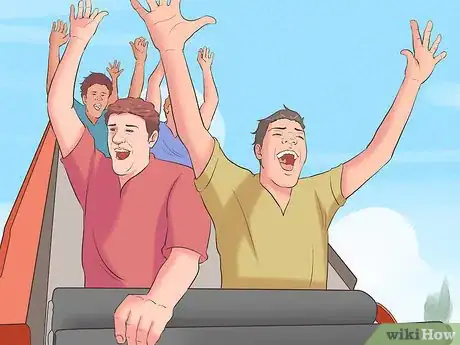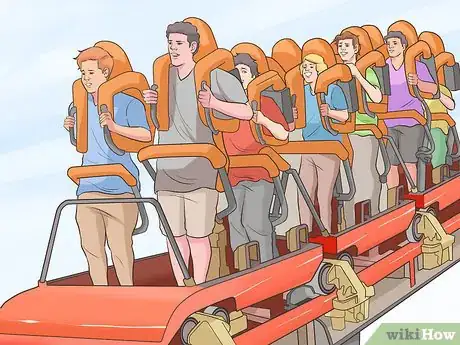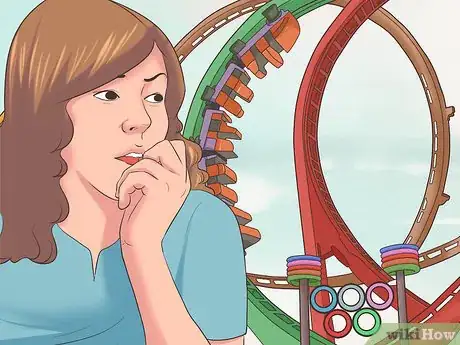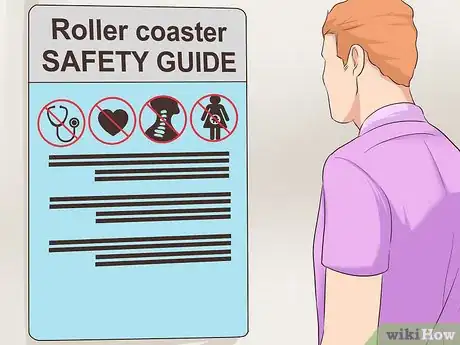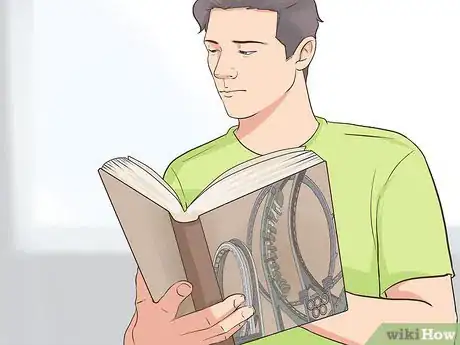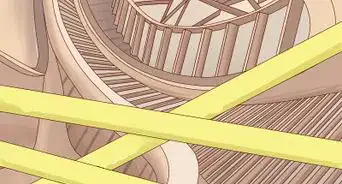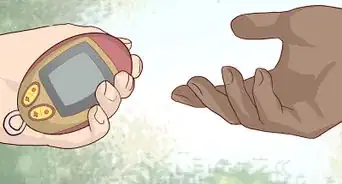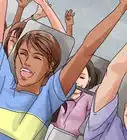This article was co-authored by wikiHow Staff. Our trained team of editors and researchers validate articles for accuracy and comprehensiveness. wikiHow's Content Management Team carefully monitors the work from our editorial staff to ensure that each article is backed by trusted research and meets our high quality standards.
There are 7 references cited in this article, which can be found at the bottom of the page.
wikiHow marks an article as reader-approved once it receives enough positive feedback. In this case, 93% of readers who voted found the article helpful, earning it our reader-approved status.
This article has been viewed 46,294 times.
Learn more...
Amusement parks are a widely loved attraction, and any great park has some serious coasters for the ultimate thrill. Roller coasters can be a great way to get an adrenaline rush, but they can also be scary for a lot of people. By picking the right seat, learning about safety features, trying out all the types of coasters, and many other steps, you can learn how to enjoy riding a roller coaster.
Steps
Overcoming a Fear of Riding
-
1Start out small. If this is your first time riding a coaster, or if your first few times terrified you, seek out the smaller coasters. Either look at the park website ahead of time to see what they offer, look at the park map to find out the sizes, and don’t be afraid to ask someone who works at the park which roller coaster would be best for a beginner.[1]
- For young riders, amusement parks often have kid-oriented coasters that give you thrill but are designed especially with kids in mind. Even if riding the child coasters isn’t an option, most parks have a range of coaster sizes so you can find one that fits you.
-
2Watch the coaster and the riders. You can get a good idea of what the ride will be like by looking at the coaster’s structure, watching a couple trains go through the circuit, and watching and listening to the riders.
- If the track has multiple big drops, loops, corkscrews, or other features that scare you, maybe pass on that particular coaster for now. Try to find one that seems like the right intensity for you.
- If you are with friends, ask if they have ridden specific coasters and can tell you about them.
- You can also ask people coming off of the ride what the experience was like for them.
Advertisement -
3Sit in the test seat. At the entrance to many roller coasters is a model of the seat featured on the ride. Before going on the coaster for the first time, try out the test seat to make sure you will be comfortable with the seat itself and the straps, pull down bars, and harnesses the seat has.[2]
- If you aren’t comfortable in the test seat, you will most likely not be comfortable once the ride is fully in motion.
-
4Sit in the middle of the train. Once you have decided to ride a specific roller coaster, you have to pick what part of the train you want to sit in. Each portion of the train will experience the ride a little bit differently, and even if the coaster itself is a good fit, certain parts of the train may not be right for you. For first time or inexperienced riders, the middle is the best spot to sit in because it offers the mildest ride.
- Sitting in the front gives you a view of exactly where you are headed, which may seem comforting in theory but can actually be scary for first time riders.
- The back of the train experiences the highest speed going down hills and tends to have the roughest ride around curves.[3]
-
5Appreciate being back on the ground. Once you have completed the ride, your body will most likely need some time to adjust to the change of being back on solid, stable ground. To finish your ride well, take a moment to appreciate the calm of walking slowly again.
- You can also purposefully take some slow breaths to calm your heart down if it is still racing from the ride.
- Another way to calm down is to talk to a friend about what the experience was like.
Trying Fun New Ways to Ride
-
1Seek new coasters. If you have already ridden coasters for a while, think about what coasters you have ridden before and seek out ones similar to that. Rather than riding the same coasters you have been on many times before, new ones of similar intensity will increase your enjoyment. If you started out with a few wooden coasters and low-key steel coasters, try moving up to a more intense steel coaster.You can even use a coaster directory to explore.[4]
- One thing to pay attention to is what type of seat the coaster has. Are your feet dangling? Are you standing up in the harness? You can tell a lot by the track and seats of the coaster.
- If you can tell for sure it goes upside down, goes super fast or you can see huge drops, consider whether you are ready for these aspects.
- Most mid-size to large parks have steel coasters that are more moderate and may be fast and high but don’t go upside down.
-
2Change how you ride. If you have only been riding for a while, maybe you have spent most of that time holding onto the lap bar or harness.
- Take the step of letting go and raise those hands up for the whole ride, as long as this is an option.
- If you have ever kept your eyes closed before, try keeping them open and seeing all the different views along the way.
- You may have noticed people tend to scream on roller coasters. This can be a fun way to release any lingering fear you may have during the ride.
-
3Sit in new locations. Inexperienced riders may take a seat wherever there is one open, but when you want to try some new, try choosing a seat you've never sat in before. Even if you have ridden the coaster many times, sitting in a new spot can change the ride.
- Sit in the very front and see things before everyone else.
- Sit in the very back for a faster and rougher ride.
- Some coasters may have forward and backward facing seats, so pick a direction you haven't faced before.
-
4Find new styles. One of the most exciting aspects of roller coasters is that there are almost endless ways they are designed, specifically regarding the types of seats and how you are positioned during the ride. Trying types of coasters you’ve never experienced is kind of like riding one for the first time.
- If you have never ridden a standing coaster, find a park that has one and go ride it. Never ridden one where you are hanging from the seat and facing the ground? You’ll feel just like you are flying. How about riding one that launches you at top speed or one that faces backwards?
-
5Take one step at a time. You might still be near the beginning of your roller coaster riding career, so you don’t have to become an all out adrenaline junkie in one trip. Try one new coaster that you were too scared of at first, or one new seat location. Don’t think that you have to tackle the whole park at once.
Learning About Roller Coaster Safety
-
1Reassure yourself by learning about safety standards. While it is true that people have been killed and injured on roller coasters, these are most commonly due to people breaking riding rules set by the park. The International Association of Amusement Parks and Attractions calculates the odds of experiencing a fatal injury on a ride at fixed-site amusement parks (such as Disney, Six Flags, etc.) to be one in 750 million.[5] Learn about what kind of safety standards parks have to follow.
- Far more people are affected by car accidents than by roller coasters, but people are rarely afraid of riding in cars.
- You could plan which coasters to ride before you go to the amusement park and you could specifically research those coasters to find out the safety features and what their track record is like. Park websites should include safety information.
-
2Read about how roller coasters work. Understanding the design of the structure and the physics at work can reassure you of their safety. You can learn how potential and kinetic energy are at work during the ride, or about how the train is attached to and slides along the track. For example, most roller coasters are attached to the track by rollers both on top of the track and on the bottom side of the track, which makes the ride safer.[6]
- The main benefit of learning about coasters is that once you know some of the physical aspects, it won’t be as mysterious to you.
-
3Learn about the history of roller coasters. Besides the scientific aspects of roller coasters, you could also reassure yourself by learning about their long history, such as when the first one in American was built (1884!). Learn about how the earliest coasters were constructed versus new techniques used today. One of the greatest safety advancements was the implementation of computers systems that control and monitor roller coasters from the start of the ride to the finish. Other improvements to safety features include padded headrests, ratcheting safety restraints, and magnetic braking systems, all of which were designed with rider safety in mind.[7]
- Visit the website of the International Association of Amusement Parks and Attractions (IAAPA) at www.iaapa.org for lots more information on safety features, regulations, and advancements.
Community Q&A
-
QuestionWhy do I feel so tired after riding a roller coaster?
 Community AnswerA roller coaster makes your adrenaline rush through your body, when you calm down, you may feel tired from the experience.
Community AnswerA roller coaster makes your adrenaline rush through your body, when you calm down, you may feel tired from the experience. -
QuestionHow do I find the best roller coaster to ride?
 RoSprinkles859Community AnswerFirst see what type you like to ride, then go to a theme park that has those rides. Relax and enjoy!
RoSprinkles859Community AnswerFirst see what type you like to ride, then go to a theme park that has those rides. Relax and enjoy! -
QuestionWhat if I am scared of the drop of a roller coaster?
 Community AnswerMost people are scared, but only those with a bad heart or illness can die from it. If you don't want to go, don't go.
Community AnswerMost people are scared, but only those with a bad heart or illness can die from it. If you don't want to go, don't go.
Warnings
- Don't ride roller coasters on a full or empty stomach to avoid becoming nauseous.⧼thumbs_response⧽
References
- ↑ http://themeparks.lovetoknow.com/What_Are_the_Best_Roller_Coasters_for_Beginners
- ↑ http://www.themeparkinsider.com/flume/201101/2278/
- ↑ https://travel.thefuntimesguide.com/riding-roller-coasters/
- ↑ http://www.coastergrotto.com/coasters.jsp
- ↑ http://www.popularmechanics.com/technology/a11078/great-unknowns-dangerous-are-roller-coasters-17087340/
- ↑ http://www.physicsclassroom.com/mmedia/energy/ce.cfm
- ↑ http://www.iaapa.org/safety-and-advocacy/safety/amusement-ride-safety/design-techology
About This Article
If you want to enjoy riding a roller coaster, start by looking for a small coaster that doesn’t have too many loops, corkscrews, or big drops. Next, try out the test seat before you get on the ride to make sure you’re comfortable with the seat, straps, and harness. When it comes time to get on the coaster, pick a seat in the middle, which offers a smoother, milder ride than the front or the back. Then, enjoy the ride and feel free to scream along the way, since that can be a good release for any remaining fear or anxiety. For tips on how to make your roller coaster ride more fun by changing the way you ride, keep reading!
